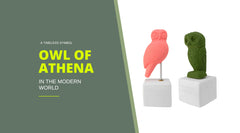Aesthetics, Art, Design - Perception and reception in ancient Greece

Aesthetics - Art - Design (Perception and reception)
Aesthetics means perception and reception, basically everything we perceive through our senses.
In ancient Greece, the term was associated with „beauty“ from the very beginning.
So, a direct line can be drawn from the ancient Greek philosophers to the scientific field of philosophical aesthetics today.
It's always about the basic question: what is beauty?
Homer already spoke of beauty and harmony; artistic creation for him was the craft, the making, but then, he said, that a God was working in it.
Pre - Socratic philosophers believed that beauty and harmony that we see in nature were based on the harmony of the cosmos, which according to the Pythagoreans was built up from numerical relationships.
Different concepts of Greek Philosophers
For Socrates „beautiful“ was what is good and true.
Plato said thinking is needed to recognize the idea of beauty in nature.
Both were „idealists“ and based their concept on natural beauty, which however for Socrates was simply present in nature, while Plato thought, pure beauty had to be found in an idea.

Aristotle reconciled the contrast between sensual appearance and idealized being.
For him, there was no abstract idea behind the things we perceive with our senses.
The goal of art, he believed, lies in its processing and implementation. In contrast to Plato, he also did not consider the onset of an emotional effect to be harmful, but beneficial.
MIMESIS, imitation of nature, is inherent in humans; the artist, however, does not merely show an image, but causes a change of mind and character through CATHARSIS, which means „cleaning, purification“.
He builds up tensions so to speak which are processed in us and cause us to change.
From here to the modern concepts of art is only a small step. In this way, art could even show „ugly", which became artistically valuable and aesthetically „beautiful“.

Beauty, design and aesthetics over the centuries
„Beauty is in the eye of the beholder“ is attributed to Thukydides, and for Epicurus, art and beauty as well as virtue and good are only interesting if they bring pleasure.
There are many threads of ancient approaches and all of them converged in later European development: Conceptions of Aesthetics and Beauty in the Middle Ages are based on Plato's idealism, in the Renaissance on the realism of the pre-Socratics and after the Enlightenment up to modernity on Aristotle's dialectic.

In principle, however, it is always the same: dealing with and reflecting on sensory perception.
The dispute never ended and is going on: whether „art“ is completely devoid of purposes, while „design“ has one, but this falls far too short.
In dealing with beauty, with aesthetics, a meaning for us, a significance, is created.
This meaning can be different for any of us, but it is important for each of us.
Pieces "mean" something to us, things that we once saw in a museum, that we remember from an exhibition of „high art“ or simply from certain situations and contexts in our lives.
The piece brings us back to a situation we live again. It induces feelings like happiness but also self- confidence and contentment.
That is why we buy them, carry them with us, put them in our rooms to have them around us. We feel inspired by them, they become a necessary part of our lives.
The old connection between aesthetics and craftsmanship, functionality and beauty is also found in the most famous art school of modernism, the BAUHAUS.
And the development continues:
Today there are university departments for product design. Internet aesthetics and web design finally belong in this category. The design object has a practical function as well as an aesthetic and symbolic one.
"Design is aesthetic in that it is always a function that is essentially shaped and that a function only gets its meaning from the form it is given", says Daniel M. Feige, contemporary Professor of Philosophy and Aesthetics.
The meaning comes from the form that is given, and the process that takes place in us. Processing and implementation. The circle in the end is closed, bringing us back to Aristotle.
P.S.
What would the ancient philosophers think seeing sculptures of their heads in color?
Would Socrates view it as not being „true“?
Would Plato be excited to find the idea behind a colored, not „natural“ head?
Aristotle, I think, would consider it like any other case: as an imitation which must first trigger a process in us. He would just be curious and explore it - that is the „modern“ way.
What are your thoughts about these colored statues? Can such modern statues be part of modern interior design?
Since you are here, check this blog post about the original colors in Greek statues.
Further reading and references:
http://classics.mit.edu/Aristotle/poetics.mb.txt
http://classics.mit.edu/Plato/symposium.html
http://classics.mit.edu/Plato/republic.mb.txt

This work is licensed under a Creative Commons Attribution 4.0 International License.
This license lets others distribute, remix, adapt, and build upon this work, even commercially, as long as they credit and link KUKUVAYA for the original creation.



















